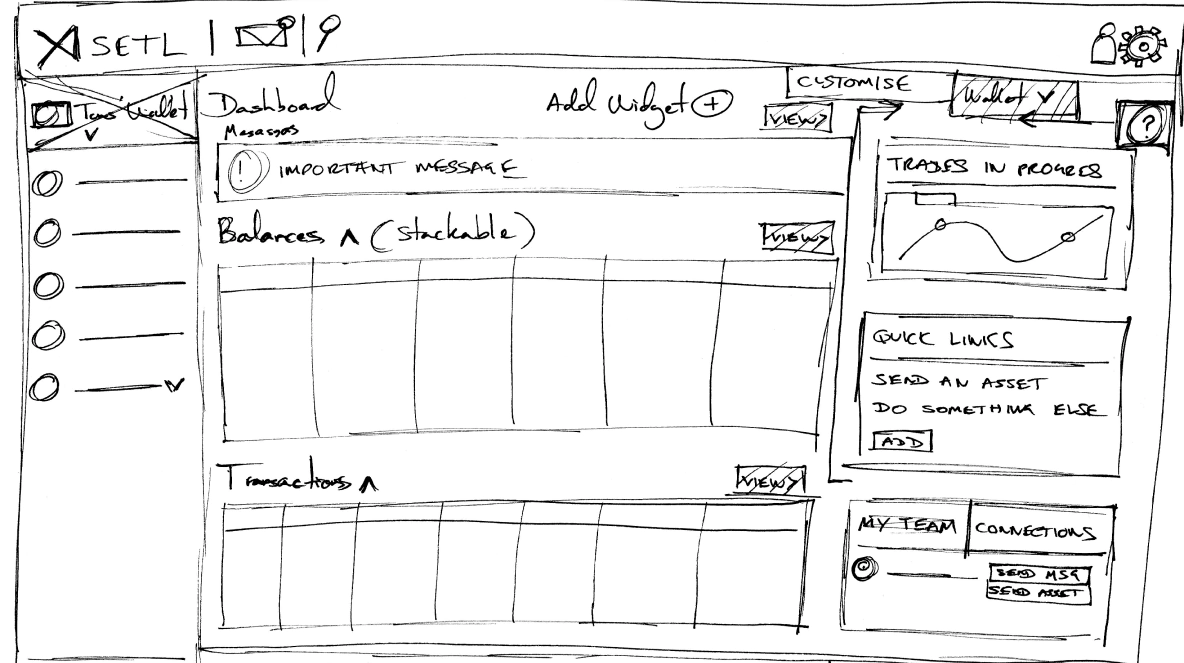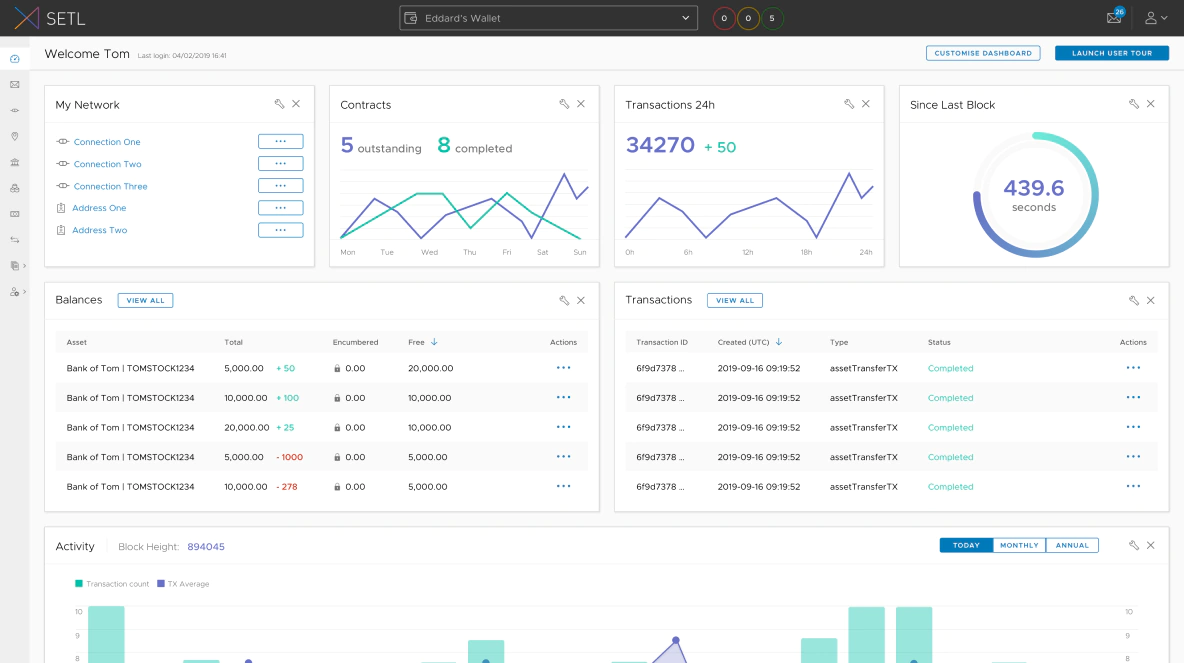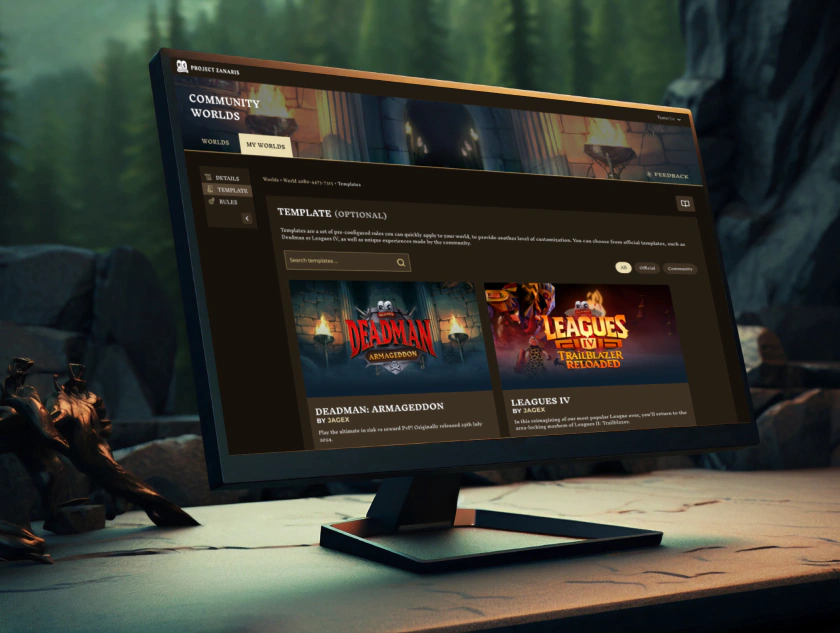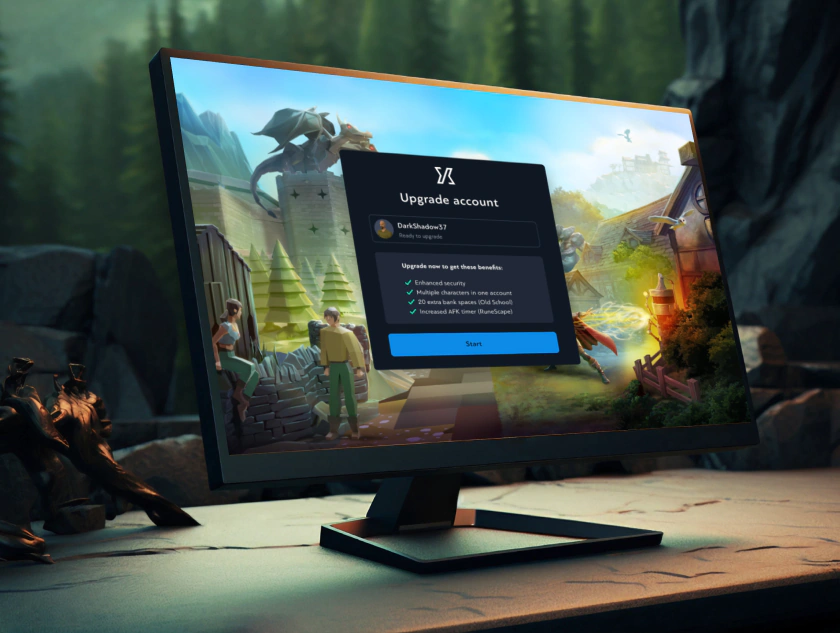SETL OpenCSD
Simplifying blockchain asset management
Key Results
- 98% task completion
- 94% onboarding confidence
- 5x faster asset distribution
- Closed beta successfully deployed

Context
As SETL's first design hire in a 40 person engineering startup, I led UX/UI design for OpenCSD — an app enabling asset managers to interact with blockchain without deep technical expertise. In 2018, blockchain promised to revolutionize finance, but asset managers managing billions were intimidated by its complexity despite wanting its benefits.
The Challenge
Build accessible blockchain UX in an emerging technology with limited user access and single client dependency. Users faced fragmented experiences with no centralized way to view transactions, distribute assets, or monitor blockchain health. Blockchain's novelty made complex operations difficult to simplify.
Research
We had an alpha app that achieved only 67% task completion with users frustrated by complexity — proving we needed user-centered redesign, not just visual polish.
Alpha Feedback
I analyzed the existing alpha state, identifying essential complexity (inherent to blockchain) versus introduced complexity (poor architecture and interaction design).
Our external partner IZNES provided crucial feedback revealing lack of customization options, unnecessarily complex workflows, and hidden features forcing workarounds.
Critical Finding
Users spent 10 minutes anxiously triple-checking blockchain transactions because they were irreversible. They needed confirmation screens and plain-language explanations to build confidence, not just technical accuracy.
Design Implication
Users didn't want blockchain education — they wanted confidence their actions were correct.
Personas
Working with the IZNES designer, I conducted user interviews with Asset Managers to understand their workflows, motivations, and pain points. Three primary personas emerged, each representing distinct user needs and risk tolerances:
- Managed €2B in assets across multiple EU funds
- Needs certainty that asset distributions execute correctly with audit trails
- Must quickly answer client questions without consulting technical teams
- Responsible for monitoring blockchain health and performance at IZNES
- Needs real-time visibility to identify performance degradation before it impacts
- Must quickly diagnose issues to escalate appropriately
- Responsible for daily reconciliation and month-end close processes
- Needs absolute confidence that blockchain transactions settled correctly
- Requires comprehensive transaction history to satisfy requirements
Design Implication
Laurent's need for trust without technical understanding became our north star — if we could make blockchain comfortable for him, we'd succeed for all user types.
User Flows
I documented existing OpenCSD user flows to understand key user goals and tasks. Since no documentation existed, this became the reference point for the team — resolving ambiguity between engineering and stakeholders.

OpenCSD User Flow
Key Decision: I redesigned the "Distribute Asset" flow to include a confirmation screen showing plain-language impact. This added one step but reduced errors from 12% to < 2% by giving users confidence before irreversible blockchain execution.
Design
My initial design exploration focused on three core daily problems: centralized dashboard (no single place to see blockchain activity), wallet switching (managing multiple digital wallets was cumbersome), and blockchain health (no visibility into network performance).
Design Principle
Abstract blockchain complexity away. Users don't need to understand Merkle trees or gas fees—they need to trust outcomes. Progressive disclosure became our mantra: show what users need to know, hide technical details unless required.

Early sketch of the SETL dashboard
Design System
The app was already using the Clarity design system (VMware open-source UI framework) in build, but we had no design libraries set up—creating consistency challenges and slowing development.
I set up Sketch Clarity libraries, components, and patterns, then integrated with Zeplin so designers and engineers had a shared source of truth. This enabled faster development and reduced design-to-dev questions by ~60%.
Impact: What previously took 2 weeks to spec and build now took 3 days. This efficiency let us iterate more within our constrained timeline.
Final Designs
I created InVision prototypes incorporating insights from UX analysis, Asset Manager testing, and modern UI patterns. The goal: create familiar experience despite blockchain's inherent complexity.

Customisable OpenCSD dashboard
Product Features
- Smart Onboarding — Progressive disclosure showing necessary information, wizard pattern breaking complex forms into chunks, and themable branding per client
- User Tour — Contextual help explaining blockchain concepts in plain language, skippable for power users but always accessible
- Customisable Dashboards — Role-specific personalization reducing cognitive load, with saved preferences per user
- Wallet Switching — Simplified 2-click switching with visual confirmation and safeguards against costly mistakes
- Dynamic Contract Builder — Flexible configuration wizard with plain-language preview before blockchain deployment
Testing Validation
Testing with IZNES asset managers revealed a key insight: Users didn't want blockchain education—they wanted confidence their actions were correct. We removed lengthy explanatory text and added clear confirmation screens instead.
Result: Higher completion rates with less content.
Impact
UX Validation
- 98% task completion (vs. 67% alpha = +46% improvement)
- 94% onboarding confidence (vs. 58% alpha = +62% improvement)
- 2-minute distribution time (vs. 10min alpha = 5x faster)
- Error rate: 12% → < 2% (10x improvement)
Efficiency Gains
- Support tickets: 40% reduction through contextual help
- Dashboard adoption: 84% actively customizing vs. using default
- Usability Score (SUS): 78 average (vs. industry benchmark of 68)
- Our 98% task completion exceeded blockchain industry standards of 55-60%
The Business Reality
OpenCSD achieved strong validation metrics in 3-month closed beta with 20 IZNES users—but never reached broader production deployment.
IZNES restructured mid-2019, eliminating our testing partner. SETL pivoted strategy early 2020 toward infrastructure-only offerings. While the UX proved blockchain accessibility was possible, business factors prevented full-scale implementation.
Tom proved that design isn't just aesthetics — it's about solving real problems. The 98% task completion vs. our 67% alpha showed us what we were missing. We now involve design from day one.
Reflections
Diversify User Access
We relied entirely on IZNES for user research and testing. When they restructured, we lost our entire validation channel. I now maintain secondary validation channels and independent recruitment options even with a primary partner.
Design Reach
OpenCSD had validated UX but business factors beyond design's control limited success. I now assess projects through both lenses: Can design solve this? What can't design solve? This clarity helps me focus effort where design creates value.
Validation Value
When OpenCSD paused, I initially felt months of work were wasted. Then I realized: Proving blockchain UX could achieve 98% completion is valuable knowledge—whether or not it ships to millions. I now design for knowledge creation as much as for shipping.
Tags
Read the full story
See how I made blockchain accessible achieving 98% task completion, 5x faster workflows, and 94% onboarding confidence.


